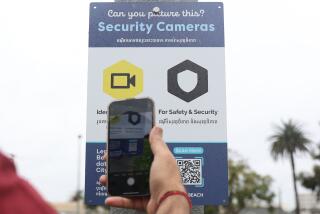A Key Witness at Crash Scenes: the Black Box
They’re small and easily forgotten, but they’re beside you on almost every trip and a witness to most accidents.
Event Data Recorders, known as black boxes, are well known in air crash investigations and are an increasing presence in modern vehicles. Hailed by safety advocates and insurance companies, data recorders provide a way to analyze crashes and are potentially a vital tool to prevent traffic fatalities.
Nearly a dozen California law enforcement agencies use details on speed and braking, among others, to aid in accident investigations.
Data recorders provide “a better idea of the crash experience,” said Susan Ferguson, vice president of research at the Insurance Institute for Highway Safety in Virginia. “They are providing useful information in some cases.”
Airplane black boxes date to the mid-20th century. Automobile data recorders appeared in the 1970s when car manufacturers began installing air bags and needed a sensing and diagnostic device to act as the brains of the air bag system, helping it deploy.
That module, a 4-by-4-inch box that is actually silver in color, typically is in a vehicle’s front end. In the 1990s, General Motors Corp. decided to use the module’s extra memory to record pre-crash data. Most newer GM cars and trucks keep five seconds of information before a crash. Although data gathered vary by manufacturer, the most common include vehicle speed, engine speed, brake status and throttle position.
Such information helped GM develop a passenger sensing system to detect smaller occupants and automatically suppress air bag deployment so children would not be injured.
“This tool is really invaluable as an objective data collection source we can use to analyze and improve the design of automobiles,” said Jim Schell, manager for product safety communications at GM in Michigan.
Most other car makers also use this technology. But GM, and now Ford Motor Co., decided to allow others access to the data. In 2000, Santa Barbara-based Vetronix Corp. began selling a data-retrieval system that enables insurance and accident investigators to download data recorder information. The California Highway Patrol and 10 other law enforcement departments in the state have the retrieval systems, which cost about $2,500.
Although the CHP’s southern region investigators have had access to black-box data for two years, they’ve used them in only about a dozen cases, in part because only certain vehicles yield the information.
“This is not a panacea for all investigating techniques,” CHP Officer Steve Kohler said. The data also can be misleading. In one case, a car had gone over a cliff and the driver kept his foot on the accelerator, causing the data recorder to give a false reading of the car’s speed during the accident, Kohler said.
They can be useful, however. Jon Cherney, an Irvine police investigator, used data recorder information to catch a Rancho Palos Verdes man in a recent hit-and-run collision. Although the man had denied being involved in the accident, Cherney said the recorder from his impounded car showed it had been in an accident in the same time period. The case is pending, he said.
“It’s one more tool in my toolbox that helps confirm what I know from the investigation,” Cherney said.
Recently, a consumer variant of the black box has become available. The device, marketed to parents of teens, emits beeps and other noises when a driver exceeds 70 mph, takes a turn too quickly or doesn’t wear a seat belt. Devices installed by car makers don’t record such regular driving details.
Who actually owns the data recorder information is a central question in the debate over whether it represents an invasion of drivers’ privacy.
“Your car effectively spies on you,” said Marc Rotenberg, executive director of the Electronic Privacy Information Center, a civil liberties group based in Washington, D.C. “It’s a little like having the guy from Allstate in the back seat of your car.”
General Motors and Ford, along with Vetronix, regard their data recorders as the property of the car owner, except in cases where the information is needed for criminal court cases.
“In our opinion, the owner of the vehicle owns the data, and if anyone else wants to download [them] they should obtain permission from the owner of the vehicle [or] request a court order or a search warrant,” Vetronix program manager James Kerr said.
Another concern is that the information collected isn’t uniform. Although more manufacturers are using data recorders and moving toward making the information available to outside investigators, there is no industry consensus on what is collected or whether manufacturers should be mandated to do so.
“What is missing is an agreement with manufacturers on collecting the data,” Ferguson said. “It remains to be seen if they will voluntarily do this or if people will push for the government to require them to do it.”
Engineering groups are trying to develop national standards. Safety Intelligence Systems, an Atlanta company headed by Ricardo Martinez, former chief of the National Highway Traffic Safety Administration, is working with IBM on a global database of crash information gleaned from recorders.
“This is a major public health problem,” said Martinez, an emergency room physician. “The fact of the matter is, we’re in the dark ages of data.”
In the meantime, auto industry officials want to educate people on the little black box of information riding around with them.
“There doesn’t seem to be much awareness right now,” Ferguson said. “The first thing we have to do is have people understand what these things are and how they work.”
*
If you have a question, gripe or story idea about driving in Southern California, write to Behind the Wheel, c/o Los Angeles Times, 202 W. 1st St., Los Angeles, CA 90012, or send an e-mail to






